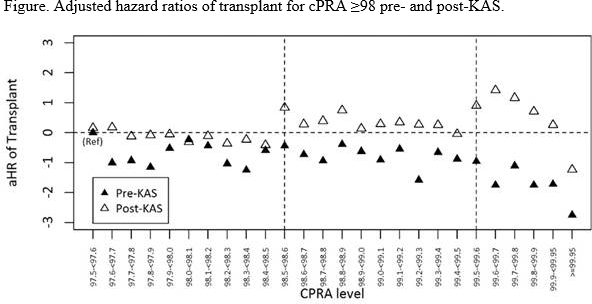Do All cPRA 100% Candidates Have Equal Access to Organ Allocation?
1Scientific Registry of Transplant Recipients, Minneapolis
2Pathology, Emory University Hospital, Atlanta
3Surgery, Johns Hopkins, Baltimore.
Meeting: 2016 American Transplant Congress
Abstract number: C67
Keywords: Alloantibodies, Allocation, Kidney, Sensitization
Session Information
Session Name: Poster Session C: Economics, Public Policy, Allocation, Ethics
Session Type: Poster Session
Date: Monday, June 13, 2016
Session Time: 6:00pm-7:00pm
 Presentation Time: 6:00pm-7:00pm
Presentation Time: 6:00pm-7:00pm
Location: Halls C&D
Renal transplant candidates with cPRA values of 98%, 99%, and 100% received local, regional, and national priority, respectively, for deceased donor kidneys with the new KAS, and were predicted to undergo more transplants. In fact, observed transplant rates per 100 person-years on the waiting list increased from 9.7 to 13.2, 8.8 to 21.6, and 2.7 to 19.1 for candidates with cPRA 98%, 99%, and 100%, respectively, 9 months before and after the new KAS. cPRA values are reported in whole numbers and candidates with actual cPRAs 97.5-98.4, 98.5-99.4, and 99.5->99.9 are "rounded up" to 98, 99, and 100. We used a Cox proportional hazards model (adjusted for race, blood type, and listing DSA) and found that likelihood of transplant trended lower in each broad cPRA category as values incrementally increased. The most dramatic decrease was in candidates with cPRA >99.95% [Figure]. We re-evaluated the results from a recent simulation wherein every DD kidney transplanted in 2010 was offered to waitlisted cPRA 100% candidates (CJSAN-in press). In that study, we found that ~75% (3983/5381) of cPRA 100% candidates were compatible with an average of 17 donors (total number of donors, 6141), while ~25% (1398/5381) were incompatible with every donor. Herein, we observed that the higher the cPRA between 99.5% and 100%, the more likely was incompatibility with every donor. We assessed the 1398 incompatible cPRA 100% candidates by incremental PRA values; 5 candidates (0.4%) had cPRA 99.50%, 18 (1.3%) 99.60%, 37 (2.7%) 99.70%, 69 (4.9%) 99.80%, and 1269 (90.8%) >99.90%. If centers knew their cPRA 100% candidates' values between 99.5% and 100%, they would better understand whether these candidates would benefit from the new KAS policy or require an alternative strategy to undergo transplant.

CITATION INFORMATION: Gebel H, Gustafson S, Segev D, Kasiske B, Israni A. Do All cPRA 100% Candidates Have Equal Access to Organ Allocation? Am J Transplant. 2016;16 (suppl 3).
To cite this abstract in AMA style:
Gebel H, Gustafson S, Segev D, Kasiske B, Israni A. Do All cPRA 100% Candidates Have Equal Access to Organ Allocation? [abstract]. Am J Transplant. 2016; 16 (suppl 3). https://atcmeetingabstracts.com/abstract/do-all-cpra-100-candidates-have-equal-access-to-organ-allocation/. Accessed December 18, 2025.« Back to 2016 American Transplant Congress
